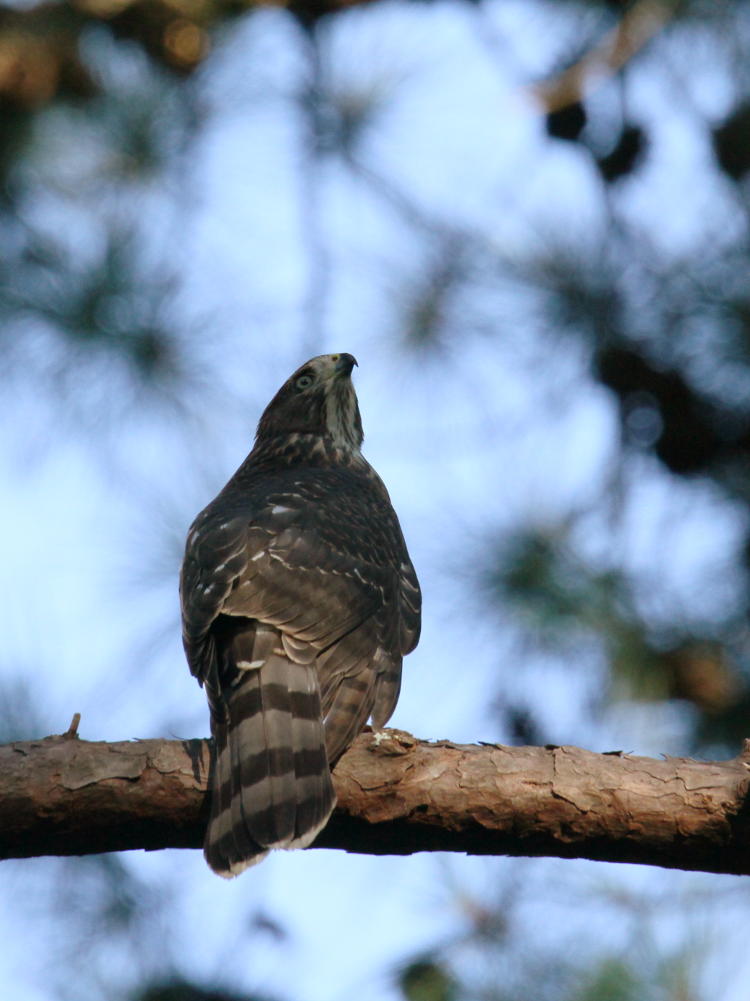
[Claps and rubs hands together] So, I’ve had most of these photos sitting in the blog folder for days, waiting for all that jazz below to be done so I could devote the time to a larger post, one that I didn’t want to double-post and try to keep track of, and the time has arrived.
I’d noticed last year that a sharpshinned hawk was starting a nest nearby, but nothing ever seemed to come of it. This spring, it seemed to be happening again, and I thought I saw the nest, in the neighbor’s yard, before the trees had fully leafed out and obscured it. Time went by, and I saw no further evidence, and figured that we were repeating last year’s performance.
Then not too long back, I began seeing a hawk off of the backyard, fairly frequently, and hearing a bare kip! call. Before too much longer, a set of more desperate cries took their place, as an assortment of newly-fledged hawks began to appear quite frequently in the area, demanding rather distinctly that mom keep the feeding process going; naturally, she wasn’t, to encourage them to get their own damn food. But it meant that I had a lot more opportunities to snag some photos.
First off, let me correct something. While the one I saw making a nest last year was definitely identified as a sharpshinned hawk by the shape of the tail, I almost accidentally discovered that these were instead Cooper’s hawks (Accipiter cooperii) – also by the shape of the tail: sharpshins have a nearly straight trailing edge to their tails, like a broom, while Coopers have a rounded shape like most birds. Otherwise, in coloration and habits, they’re almost identical. Coopers are larger, with larger heads, but size-wise they overlap; males of both species are smaller than the females, and a male Coopers can be about the same size as a female sharpshin. They are also both bird-eaters, extremely fast and maneuverable accipiters that hunt in the forest canopy and tend to be shy and a bit secretive about their perches. As adults, anyway; the kids are much less so, especially when they think they should be being fed.
Another thing to note: off the back of the property, the trees get pretty thick, and it’s very easy to be within a few dozen meters of a bird and see not the faintest sign of it. I had to take a frame to illustrate this, standing in a clearing for buried utility lines just beyond our fence.
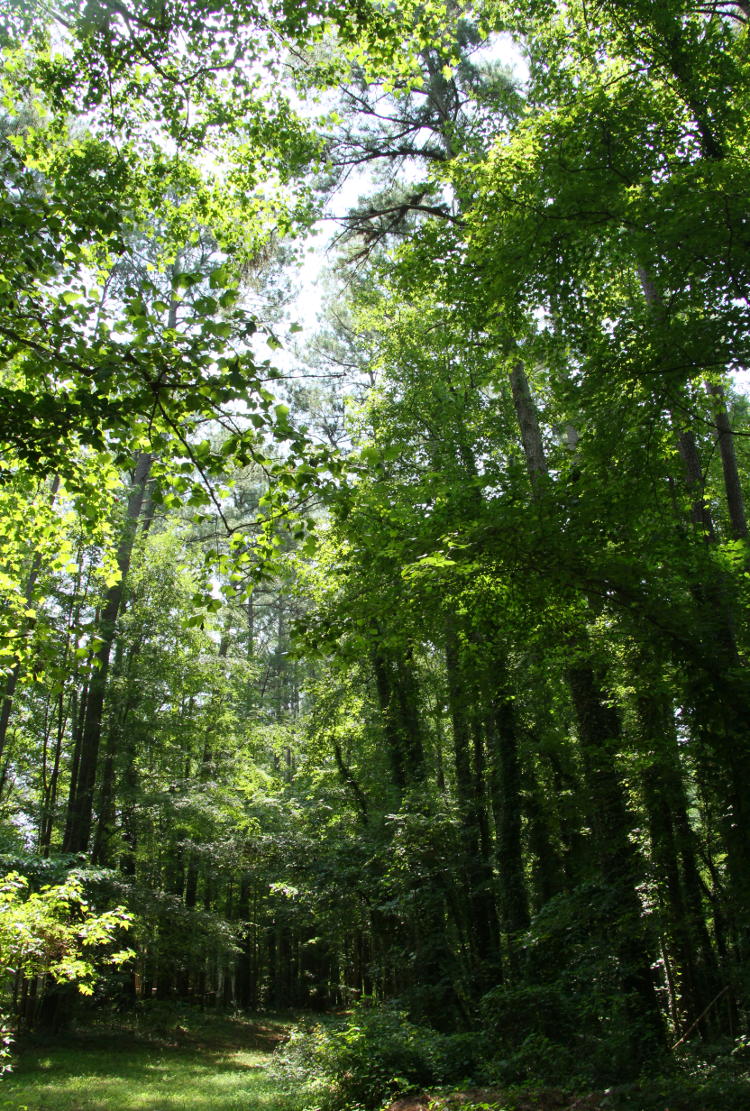
I think that gives a good enough impression. It was easy to know one or two were around, even catch a glimpse of them flitting among the branches, but nice clear views were scarce. Still, over a couple of weeks I managed to snag more than enough for a post.
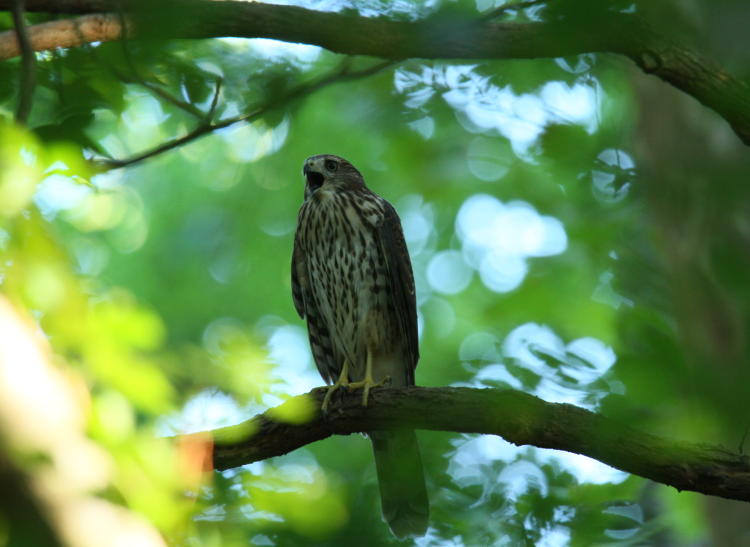
… especially when they attracted so much attention by calling. I would only have had half as many photos had they been silent, and I had to rely on spotting their movement or perched outlines, but hey, do you hear me complaining? And knowing that accipiters tend to be very wary of people, I took pains to be quiet, unobtrusive, even motionless whenever possible, but it appeared that the young ones hadn’t studied their own species’ traits very well, because eventually I realized that the Girlfriend and I could stand directly beneath one and converse quietly without provoking flight. This also made it easier. As did the occasional perch in one of the few clear patches.
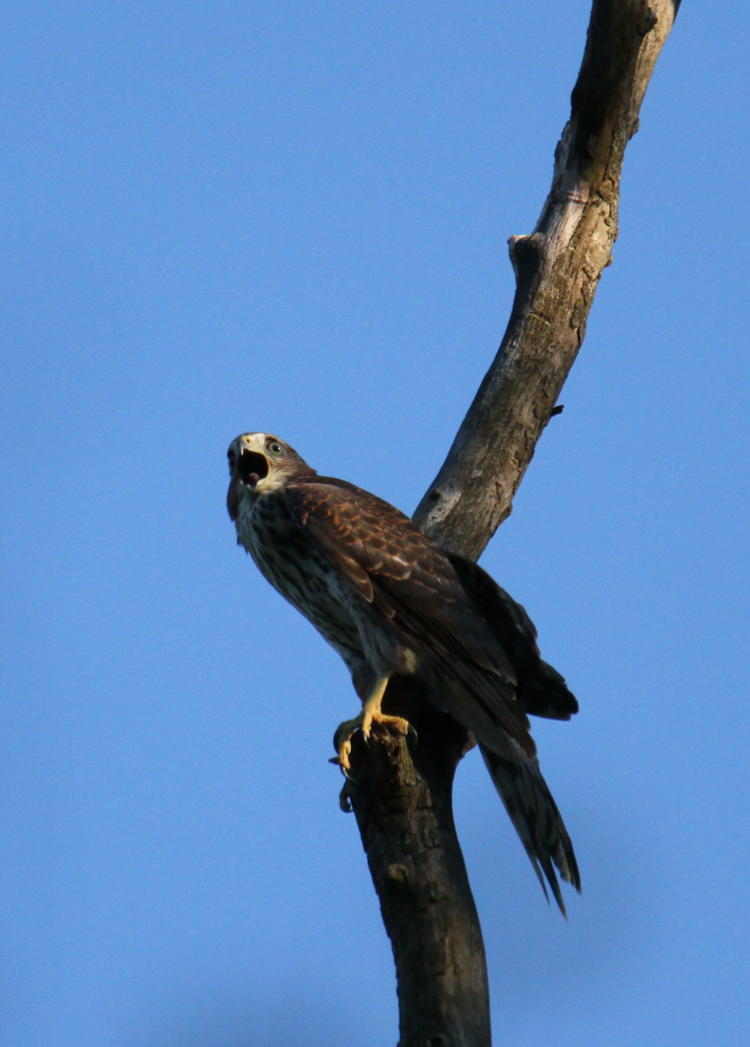
Yes, I was timing shots to catch them in mid-call, not exactly difficult; they don’t sit around perpetually yawning or anything. The Girlfriend told me that I’d missed mom feeding the young a fresh kill down in the clearing, because I hadn’t gotten home yet, but checking that spot some thirty minutes later, one of the brood was still poking around for scraps. I think this image is the first of the detail shots that I obtained, with everything else in this post coming later, some within the hour.
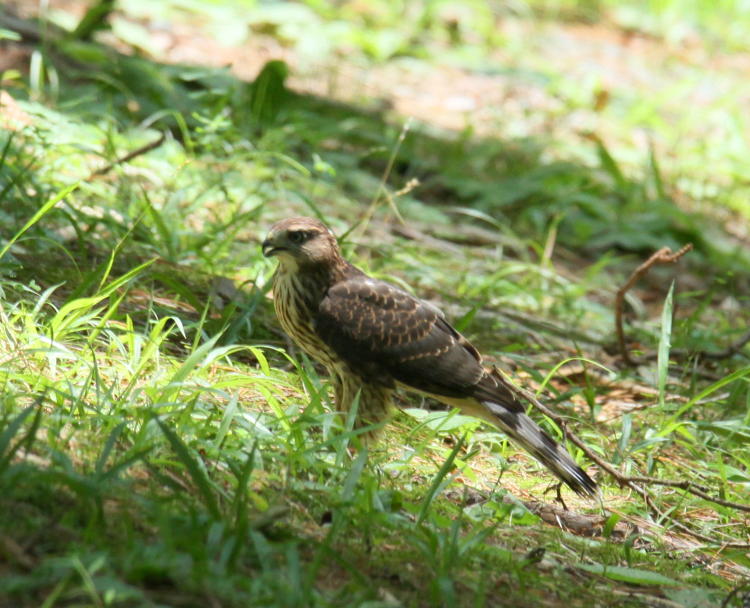
The young were also spending an inordinate amount of time down at low levels, perching on stumps and low branches, which seemed odd to me, but I may not be familiar enough with their habits either. Coopers are medium-small raptors, about the size of crows, and their lifting ability isn’t too impressive because of that, so perhaps they tend to eat their prey on the ground when it seems safe rather than try to carry it to a perch out of reach of other predators. Or, like all the noise they were making, perhaps they just hadn’t learned good habits yet.
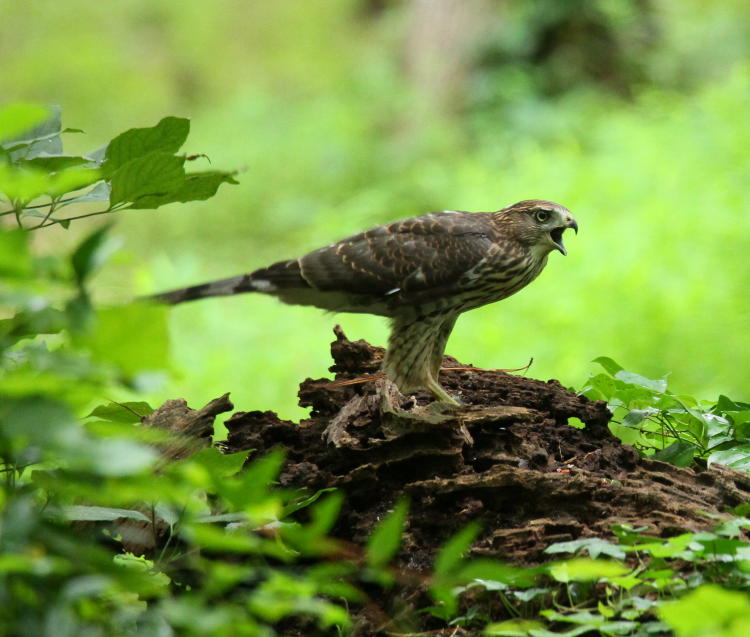
They appeared to have a few favored spots, which made it a little easier to get some frames, but they were working an area perhaps 50 meters square and would pause where the mood struck them, making me shift position to try for the best vantage – very often, it would be partially obscured by intervening vegetation, so what you’re seeing here are the successes among a couple of hours, all told, of active shooting, spread among about two weeks.
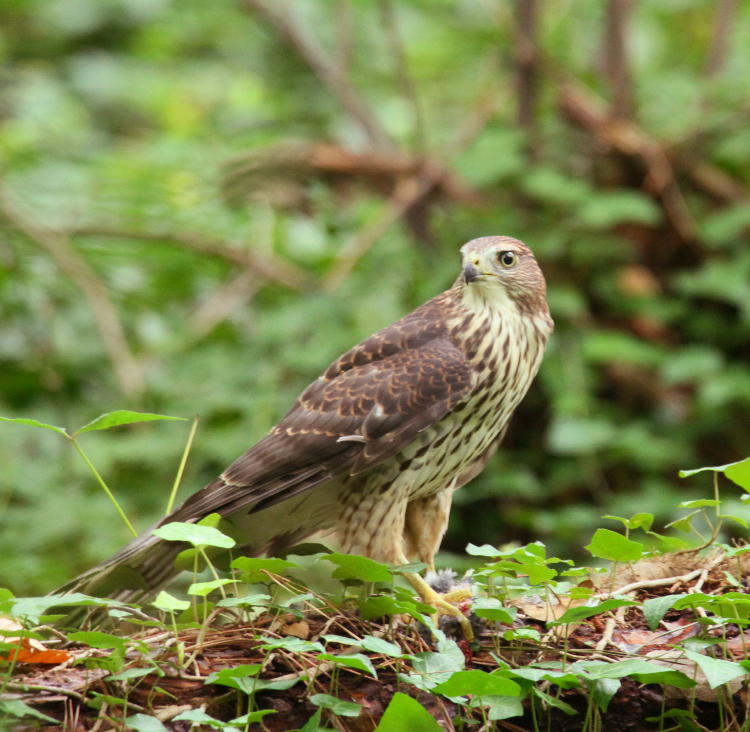
This stump was about twelve or so meters away, partially hidden behind thick undergrowth, so I was shifting position carefully to get the best view, trying not to disturb the hawk. I did not see it carrying anything when it came in to land, but the attention it kept paying to the spot at its feet seemed to indicate that it had something to eat, and what you’re seeing here is a closer crop – I wasn’t getting this good a look in the viewfinder, especially not with a handheld 600mm lens bouncing around unsteadily. All of my sessions were spur of the moment without a tripod, grabbing the camera when I was available and hearing the juvies making a racket. I’d intended to do some more ‘serious’ sessions, perhaps even with video (which would require a tripod to prevent motion sickness from the viewers,) but even a tripod is a questionable accessory, since it all depends on where they are and what they’re doing. It’s not easy to surreptitiously shift a tripod to a better position to get that view through the foliage, or aim it nearly straight up into the canopy overhead, when a hawk with far better eyesight than humans is sitting a stone’s throw away. I wasn’t doing too shabby handheld, for all that, but yes, the image stabilization was absolutely necessary.
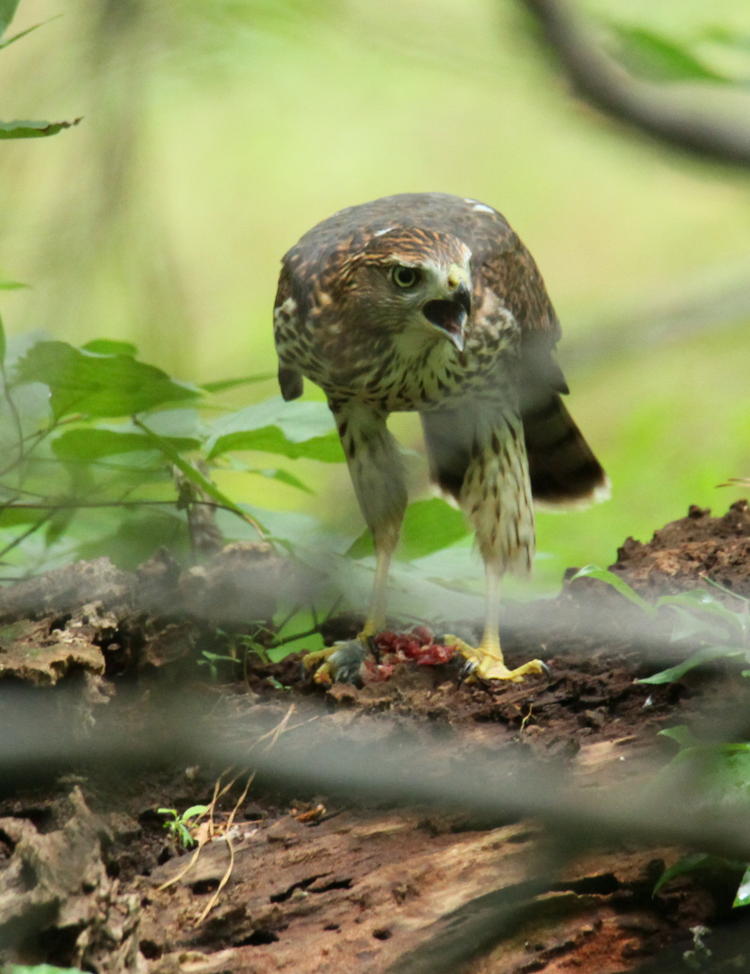
This is the same hawk as above, same timeframe, after scooting (well, shuffling quietly,) to my right a handful of steps, and now the prey is visible. They would still vent a call at times even while eating, which was also slightly puzzling; I wouldn’t think any raptors, as competitive as they tend to be as soon as they can sit upright, would draw attention to themselves when they had food that could be stolen, but maybe the continued calling was misdirection, begging for food to disguise the fact that they had any. I doubt this myself, but for now, I can’t offer any explanation. Better to talk to an ornithologist; as I’ve said, I just takes picchers of ’em.
A few days back, I got extremely lucky with my timing, coming down the back deck steps just as one cruised across the backyard, showing by its flight profile that is was coming in for a landing. I quickly grabbed the camera again and started the slow stalk across the backyard. Soon enough, I discovered that a pair was sitting on the ground between ours and our neighbors’ fences, unfortunately obscured by slats, but I stayed put and watched, hoping they had prey and I could slip closer while they were occupied. This kinda worked, but they were aware of my presence, closer than it had been before.
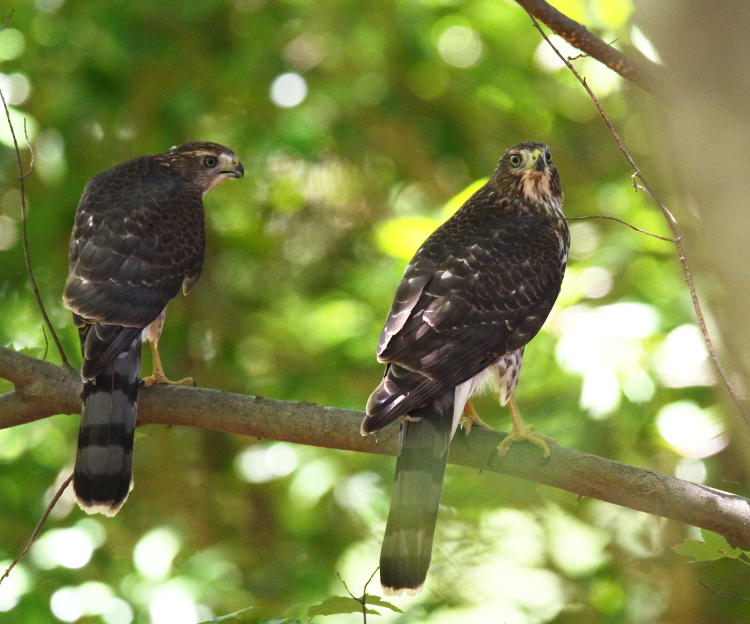
Wary of me, the pair flew up to a nearby branch and watched carefully, which I was fine with because now they were in better light and a clear view. To the best of my knowledge (judging from the coloration and behavior,) these are both still juveniles, and thus demonstrate the size difference between male and female, the female being on the right. Again, about crow size, so maybe 35-45cm in overall body length counting that long tail. But I had to save the best for last, of course.
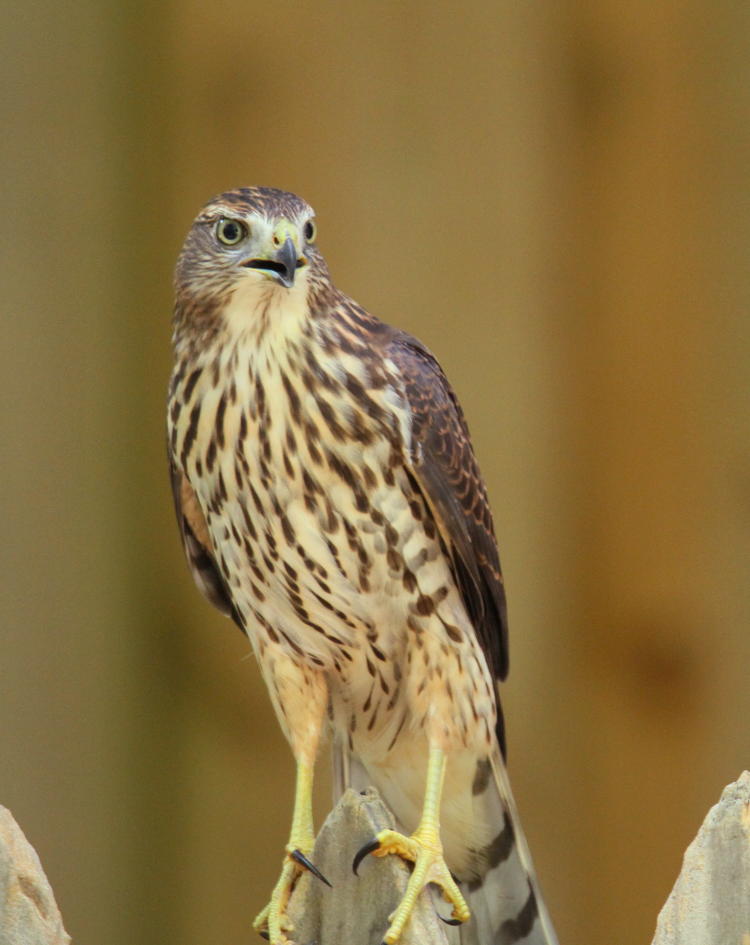
One of them opted to fly up to our own fence and perch in direct sight, not eight meters off – that’s the neighbor’s fence in the background. Nice view of the long, thinner legs and the remarkably long talons. Accipiters can catch birds in midair and are adapted for this, while the buteos like the red-shouldered and red-tailed hawks strike their prey violently on the ground more often, so have heavier legs and shorter, thicker talons. I’m gonna peg this one as the male, comparing it with the image above and noting the fewer dark fathers under the chin.
But yeah, it’s been a productive few weeks photographically, even when it hasn’t been reflected here. And more are on the way.




















































